30+ Tips For Successful Follow-Up After Sending A Sales Proposal
After sending a sales proposal, the follow-up is where deals are won or lost. But how do you stay persistent without being pushy?
— Propoze
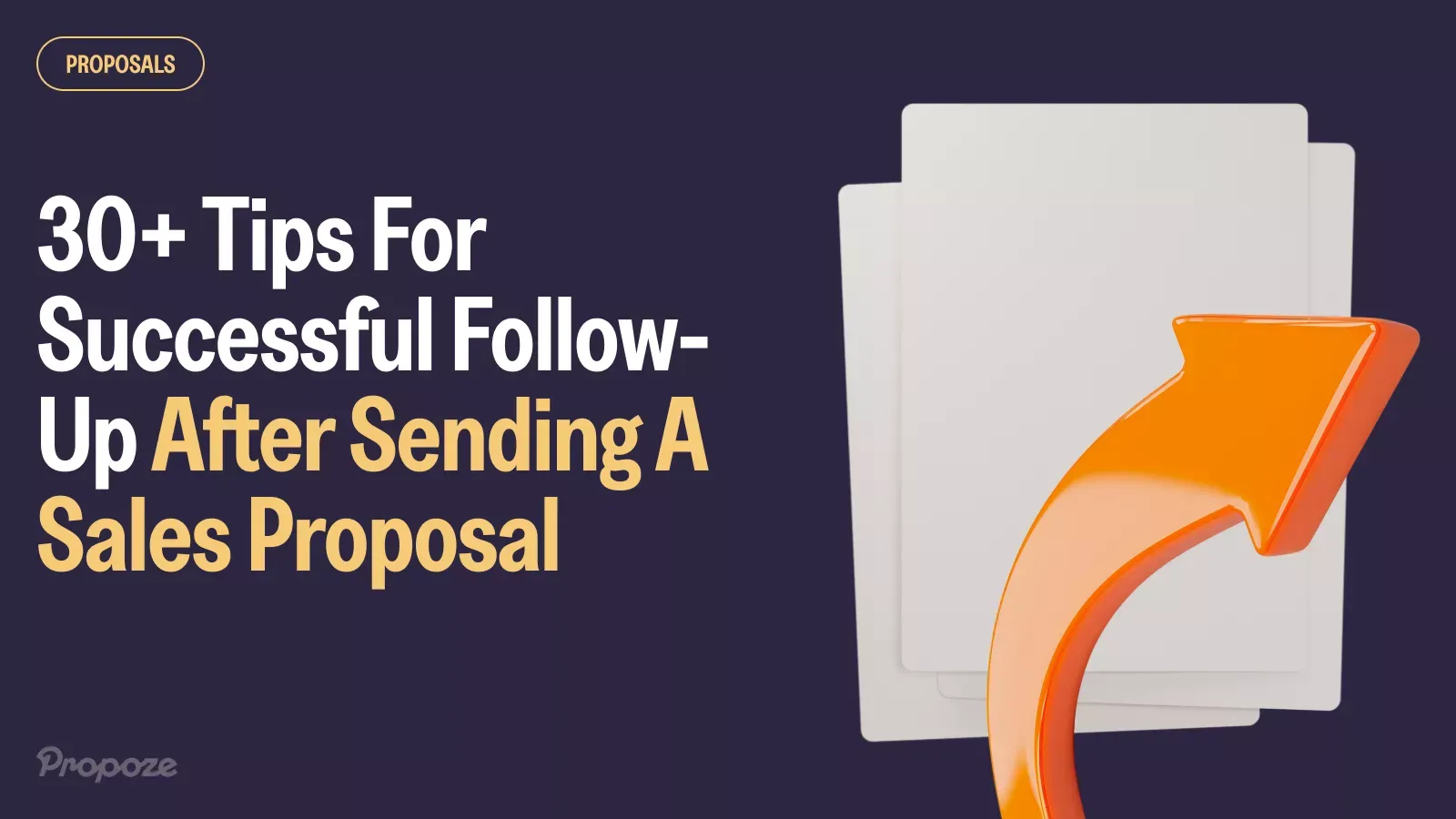
Following up can be the difference between a stalled deal and one that moves forward.
But how do you stay on their radar without being pushy?
The key is to focus on timing, tone, and making sure every message adds real value. Effective email follow ups are essential tools for nurturing leads through the sales funnel.
Utilizing a follow up email template can help maintain engagement with potential clients by providing structured and thoughtful communication. It’s all about being persistent, but respectful.
Let’s walk through how to follow up the right way, so you can boost response rates and close more deals without annoying your prospects.
Understanding the importance of follow-Up emails
Follow-up emails are a crucial component of any sales strategy, playing a vital role in building relationships with prospects, nurturing leads, and ultimately driving conversions.
By sending targeted and timely follow-up emails, businesses can re-engage with potential or existing clients, stay top of mind, and add value to their interactions.
Why follow-up emails matter
Follow-up emails matter for several reasons:
- Re-engagement: Follow-up emails help re-engage with prospects who may have gone cold or forgotten about the initial conversation. A well-timed follow-up can reignite interest and bring the prospect back into the sales process.
- Nurturing leads: Consistent follow-ups nurture leads through the sales funnel, increasing the chances of conversion. By staying in touch, you can guide prospects through their decision-making process and address any concerns they might have.
- Adding value: Follow-up emails provide an opportunity to add value to the prospect’s journey, whether through educational content, exclusive offers, or personalized support. Each follow-up should offer something beneficial, making the prospect more likely to engage.
- Building trust: Regular follow-ups demonstrate a business’s commitment to the prospect’s needs, building trust and credibility. By showing that you are attentive and responsive, you can establish a strong foundation for a long-term relationship.
Benefits of consistent follow-up
Consistent follow-ups offer numerous benefits, including:
- Increased conversions: Regular follow-ups can lead to higher conversion rates, as prospects are more likely to engage with a business that shows interest in their needs. Persistence, when done respectfully, can significantly boost your chances of closing deals.
- Improved customer relationships: Follow-up emails help build strong relationships with customers, leading to increased loyalty and retention. By maintaining regular contact, you can ensure that your clients feel valued and supported.
- Enhanced brand awareness: Consistent follow-ups keep a business top of mind, increasing brand awareness and recognition. This can be particularly important in competitive markets where staying visible is key to standing out.
- Better sales forecasting: By tracking follow-up email performance, businesses can refine their sales forecasting and pipeline management. Understanding how prospects respond to follow-ups can provide valuable insights into the effectiveness of your sales strategy.
Why follow-up emails are crucial after a sales proposal
Mastering follow-up emails can be the key to moving deals forward.
But how do you keep your prospect engaged without feeling overbearing?
An effective email subject line is crucial in securing the recipient's attention and increasing open rates.
The secret is all in the balance—getting the timing right, striking the perfect tone, and delivering real value with every message. Persistence is important, but so is respect.
Let’s explore how to follow up effectively, staying on their radar without crossing the line, and turning more prospects into closed deals.
Key statistics on sales follow-up success
The numbers don’t lie—follow-up emails can drastically improve your chances of closing deals. Research shows that:
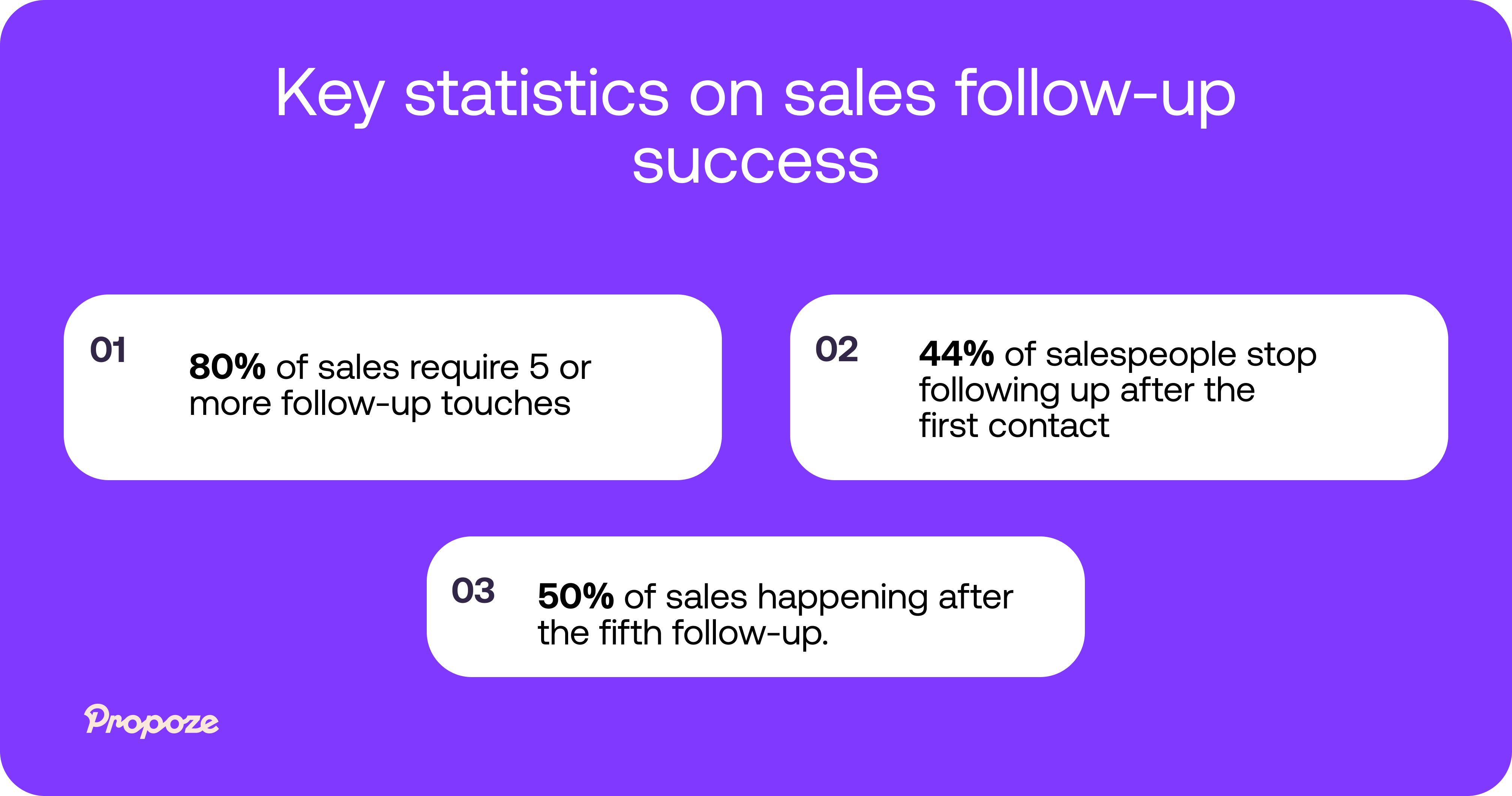
These stats really show how important it is to be consistent with your follow-ups.
Being persistent, but in a thoughtful way, helps you stand out and boosts your chances of success.
The cost of missed follow-ups in B2B sales
Missing follow-ups can result in significant lost revenue. Studies show that 60% of clients never respond to a proposal without follow-up, meaning that the initial outreach is often just the beginning.
Without consistent follow-ups, even well-qualified leads can slip away to competitors.
In B2B sales, where deals can take months to close, missing these crucial touchpoints can be the difference between closing the deal or losing it entirely.
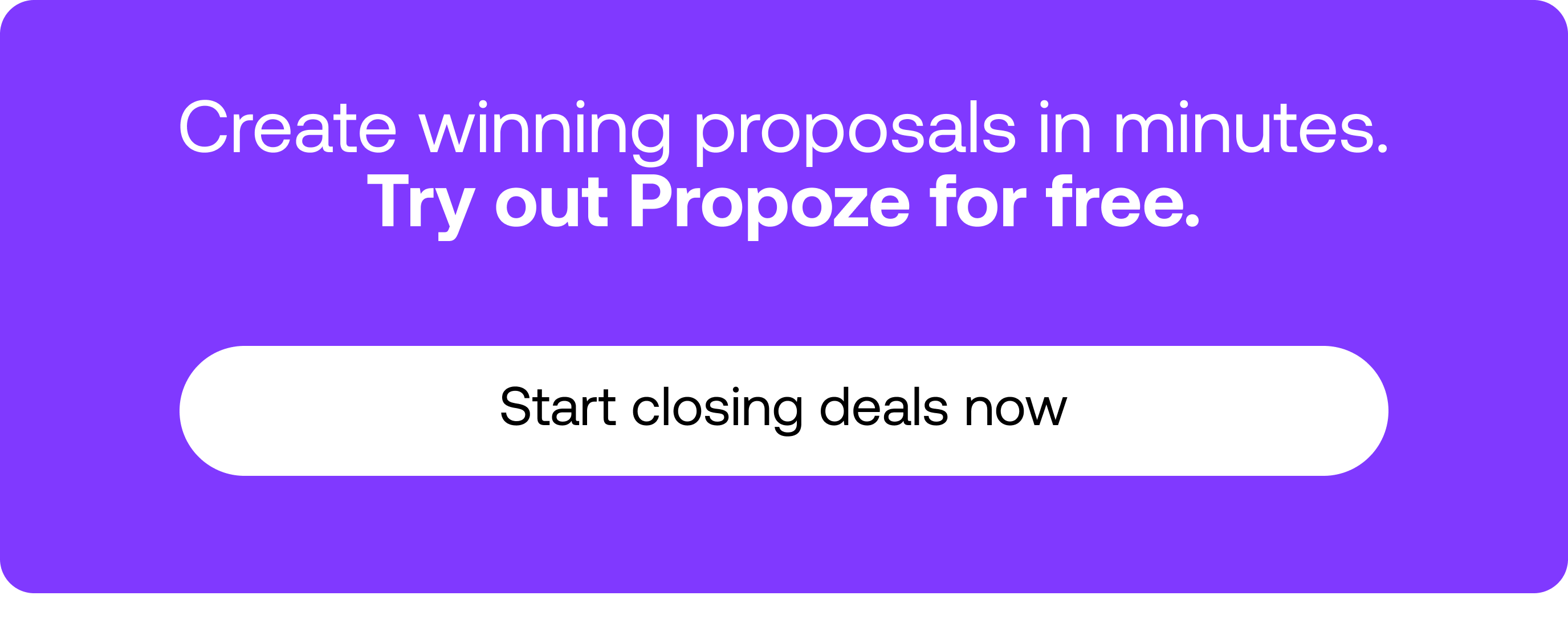
Tips for successful follow-up after sending a sales proposal
Sending a sales proposal is a big step, but it’s often the follow-up that really seals the deal.
To keep your offer top of mind and show your commitment, having a solid follow-up strategy is essential.
Crafting a customized follow-up email sequence can enhance response rates and effectively move prospects through the sales pipeline. It’s your chance to keep things moving, answer questions, and build a connection with your prospect.
Understanding the prospect's company allows you to tailor your outreach to their specific needs and establish a stronger connection.
Below, we’ll break down the most effective tips into three main categories: timing, writing the perfect message, and how to personalize follow-ups while using
automation to stay efficient.
Crafting the perfect follow-up amail
Crafting the perfect follow-up email requires careful consideration of several key elements, including the subject line, email content, and call-to-action.
Writing a clear call to action
A clear call-to-action (CTA) is essential in a follow-up email, as it directs the prospect towards the desired action. When writing a CTA, consider the following best practices:
- Be specific: Clearly state what action you want the prospect to take, whether it’s scheduling a call, requesting a demo, or making a purchase. Specificity removes ambiguity and makes it easier for the prospect to understand the next steps.
- Use action-oriented language: Use verbs like “Schedule,” “Request,” or “Get Started” to create a sense of urgency and encourage action. Action-oriented language can motivate the prospect to take immediate steps.
- Make it prominent: Display the CTA prominently in the email, using a clear and visible font, and consider using a button or link to make it stand out. A well-placed CTA ensures that it catches the prospect’s eye and is easy to find.
- Use a sense of urgency: Create a sense of urgency by adding a deadline or limited-time offer to encourage the prospect to take action sooner rather than later. Urgency can prompt quicker responses and help move the sales process forward.
By incorporating these best practices into your follow-up email strategy, you can increase the effectiveness of your emails and drive more conversions.
Follow-up email templates
Here are some follow-up email templates for different scenarios:
Use cases for different scenarios
- After a Meeting: Use a follow-up email to thank the prospect for their time and reiterate the next steps discussed during the meeting.
- Example:Subject: Following up on our meeting
Hi [Prospect’s Name],
I wanted to follow up on our meeting last week and thank you again for your time. I hope you found our discussion helpful and informative. As we discussed, I’d like to provide you with some additional information about our product/service that I think would be of interest to you.
Please let me know if you have any questions or if there’s anything else I can provide to help you make a decision.
Best regards, [Your Name]
- After Sending a Proposal: Use a follow-up email to check in with the prospect and answer any questions they may have about the proposal.
- Example:Subject: Checking in on our proposal
Hi [Prospect’s Name],
I hope you’re doing well. I wanted to follow up on the proposal I sent last week and see if you had any questions or needed further clarification. I’m here to help with any information you might need to make your decision.
Looking forward to your feedback.
Best regards, [Your Name]
- After a Demo: Use a follow-up email to thank the prospect for their time and provide additional information or resources related to the demo.
- Example:Subject: Additional resources after our demo
Hi [Prospect’s Name],
Thank you for taking the time to join our demo session. I hope you found it insightful. As promised, I’m sharing some additional resources that might help you better understand how our product can benefit your team.
Please feel free to reach out if you have any questions or need further information.
Best regards, [Your Name]
- After a Phone Call: Use a follow-up email to summarize the discussion and provide any additional information or resources requested during the call.
- Example:Subject: Summary of our call
Hi [Prospect’s Name],
It was great speaking with you earlier today. I wanted to summarize our discussion and provide the additional information you requested. Here are the key points we covered:
- [Point 1]
- [Point 2]
- [Point 3]
Please let me know if there’s anything else you need.
Best regards, [Your Name]
- After a Trade Show or Event: Use a follow-up email to thank the prospect for visiting your booth and provide additional information or resources related to your product or service.
- Example:Subject: Great meeting you at [Event Name]
Hi [Prospect’s Name],
It was a pleasure meeting you at [Event Name]. I hope you enjoyed the event as much as we did. I wanted to follow up and provide some additional information about our product/service that we discussed.
Please let me know if you have any questions or need further details.
Best regards, [Your Name]
Remember to customize your follow-up email templates to fit your specific needs and the scenario you’re using them for.
Common mistakes to avoid
When crafting a follow-up email, it’s essential to avoid common mistakes that can harm your chances of getting a response. Here are some mistakes to watch out for:
Not following up at all
One of the biggest mistakes you can make is not following up at all. After sending a proposal or making initial contact, it’s crucial to have a consistent follow-up process in place.
Without follow-ups, even the most promising potential clients might forget about your offer amidst their busy schedules. A well-timed follow-up email keeps you on their radar and shows your commitment to their business.
Following up too aggressively
While it’s important to be persistent, following up too aggressively can backfire. Bombarding your prospects with multiple follow-up emails in a short period can come across as pushy or even spammy.
Give your prospects space and time to respond. A balanced approach, where you gradually increase the time between follow-ups, shows respect for their decision-making process and keeps the conversation professional.
Not providing value
A follow-up email that doesn’t provide value can make it seem like you’re only interested in closing the sale. Instead, each follow-up should offer something beneficial to your prospect.
This could be additional insights, relevant resources, or answers to potential questions. By consistently providing value, you build trust and demonstrate that you’re genuinely interested in helping them, even if they’re not ready to buy yet.
10 tips for timing your follow-up
Getting the timing right on your follow-up is key. Send it too early, and you might seem pushy. Wait too long, and they might forget about you.
Here are 10 simple tips to help you find the perfect timing so your follow-ups feel natural, helpful, and more likely to get a response.
Tip #1 Send your first follow-up within 24-48 hours
The 24-48 hour window is the perfect time to show you’re responsive without being pushy.
It’s not just about reminding them—you’re offering support and ensuring they feel confident in moving forward.
How to implement: Frame your follow-up as a continuation of the conversation. Acknowledge their time and subtly remind them why your proposal matters.
Use approachable language, but don’t shy away from reaffirming the value you bring.

This keeps it conversational but drives home that you’re ready to assist without being pushy.
Real-life application: Imagine you’ve sent a proposal for a new software solution to a mid-sized company. Two days later, they might still be reviewing, or even worse, they may have pushed it aside due to other priorities.
By checking in early, you can reignite their focus and make it easier for them to ask for clarifications.
When to use: Use this tip in every deal where no response is received within 24-48 hours. It’s especially useful when dealing with busy prospects who might overlook the proposal due to daily noise.
This ensures your offer doesn’t get lost in the shuffle, reminding them gently of its importance. A polite follow up email can help maintain a courteous tone and encourage a response.
Tip #2 Avoid following up on Mondays or Fridays
Timing is everything when following up. Avoid Mondays and Fridays to increase the chances of your email being opened and acted upon.
Mondays are often filled with meetings, catching up from the weekend, and high inbox volumes, while Fridays are focused on wrapping up the week and preparing for the weekend.
How to implement:
Schedule follow-ups mid-week (Tuesday through Thursday) when decision-makers are more focused and available to respond. Tools like email schedulers can help automate this process to hit the perfect timing.
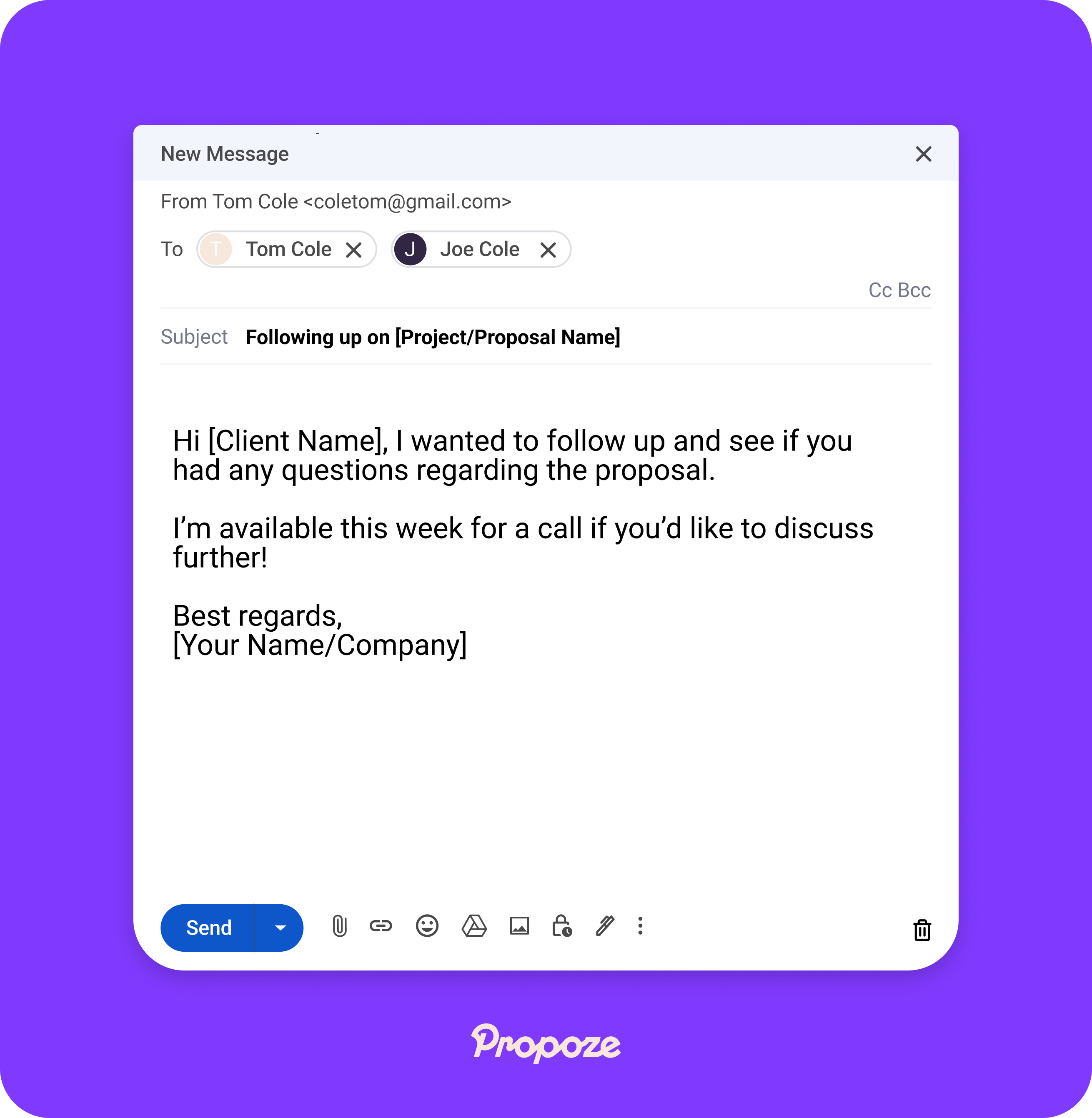
Real-life application:
Let’s say you send a proposal to a large corporation. If you follow up on Monday, the email risks getting buried in the flood of post-weekend inboxes.
On Friday, people may be winding down, pushing your email to next week. By strategically following up mid-week, you catch them at their most productive.
When to apply:
Use this tactic for every follow-up to maximize open rates. Tuesday through Thursday are statistically the best days for response rates, especially between 10 AM and 2 PM.
Tip #3 Use business hours for maximum visibility
Sending follow-ups during standard business hours (9 AM - 5 PM) drastically improves visibility and response rates.
Decision-makers are more likely to check and respond to emails when they are in "work mode," whereas off-hours emails can get lost or deprioritized.
How to implement:
Aim for mid-morning (10 AM - 12 PM) or early afternoon (1 PM - 3 PM) for maximum engagement. Use email scheduling tools to ensure your follow-ups hit inboxes at the right time, even if you’re unavailable.

Real-life application:
Suppose you’ve sent a proposal to a fast-growing tech company. If you follow up at 7 AM or late at night, your email could sit unnoticed in their inbox. But if you time it for late morning or early afternoon, it’s more likely to be seen and acted upon immediately.
When to apply:
This applies to all follow-ups. Studies show emails sent during business hours have significantly higher open rates compared to those sent outside working hours.
Avoid sending emails too early or late to ensure they're noticed when your prospect is most active.
Tip #4 Wait 3-5 days for the second follow-up
Following up too soon after your initial email can come off as desperate, but waiting too long risks losing momentum. The sweet spot is typically 3-5 days after your first follow-up.
In your second follow-up, you can reference the previous email to remind the recipient of your initial communication and encourage a response.
This gives your prospect enough time to review your proposal without feeling pressured while keeping you top of mind.
How to implement:
Schedule your second follow-up 3-5 business days after the initial follow-up, using a respectful tone. Offer additional support or clarification to gently encourage a response.
Real-life application:
Imagine you’ve submitted a proposal for a large partnership. After a friendly first follow-up, waiting 3-5 days gives your client breathing room. If they were busy or focused on other tasks, this second nudge re-engages them without feeling like you're pushing too hard.
When to apply:
Use this for deals where initial engagement is lacking, or when a prospect shows interest but hasn’t made a move. This window balances patience and persistence, ensuring your proposal isn’t forgotten, but your client doesn’t feel rushed.
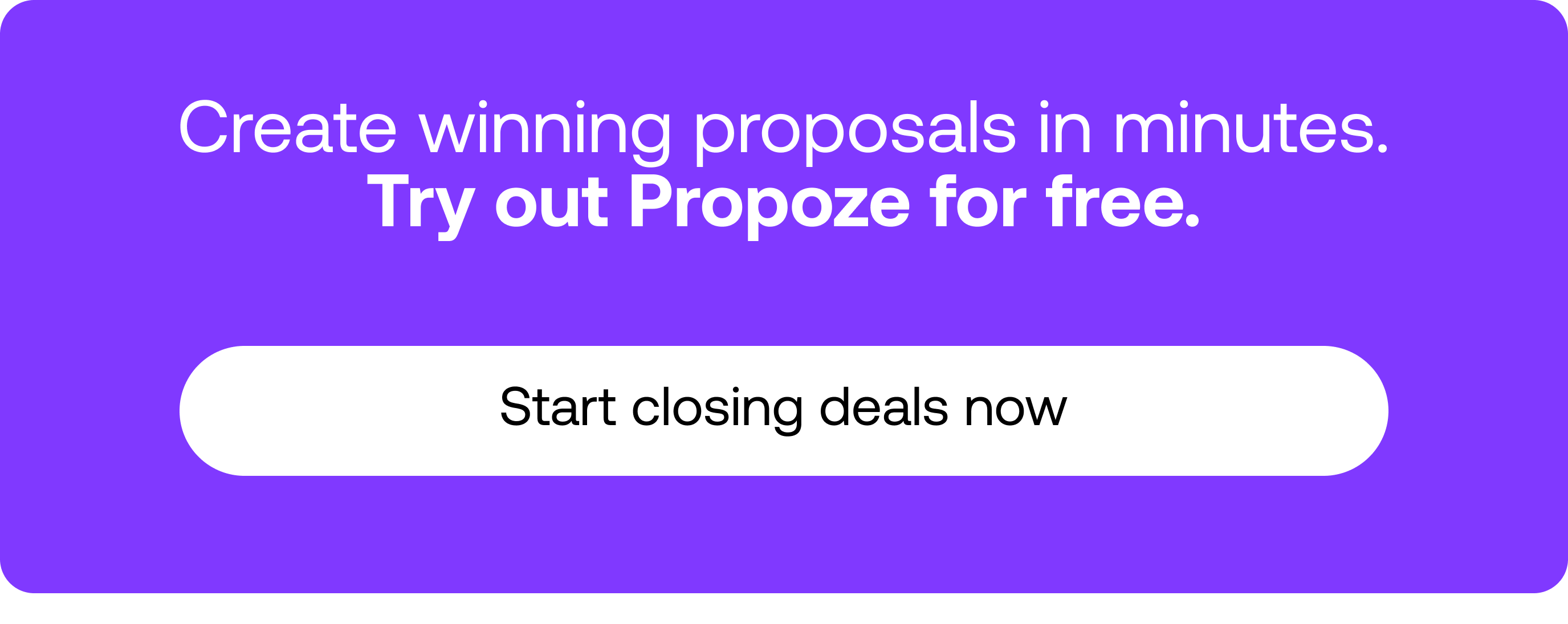
Tip #5 Increase time gaps gradually with each follow-up
As the follow-up process continues, giving the prospect more breathing room between emails shows patience and respect for their decision-making.
Start with shorter gaps (3-5 days) and increase them to a week or more as needed. This keeps the conversation alive without overwhelming them.
How to implement:
After your second follow-up, extend the next touchpoint to 7-10 days, and the following one to 2-3 weeks if needed.
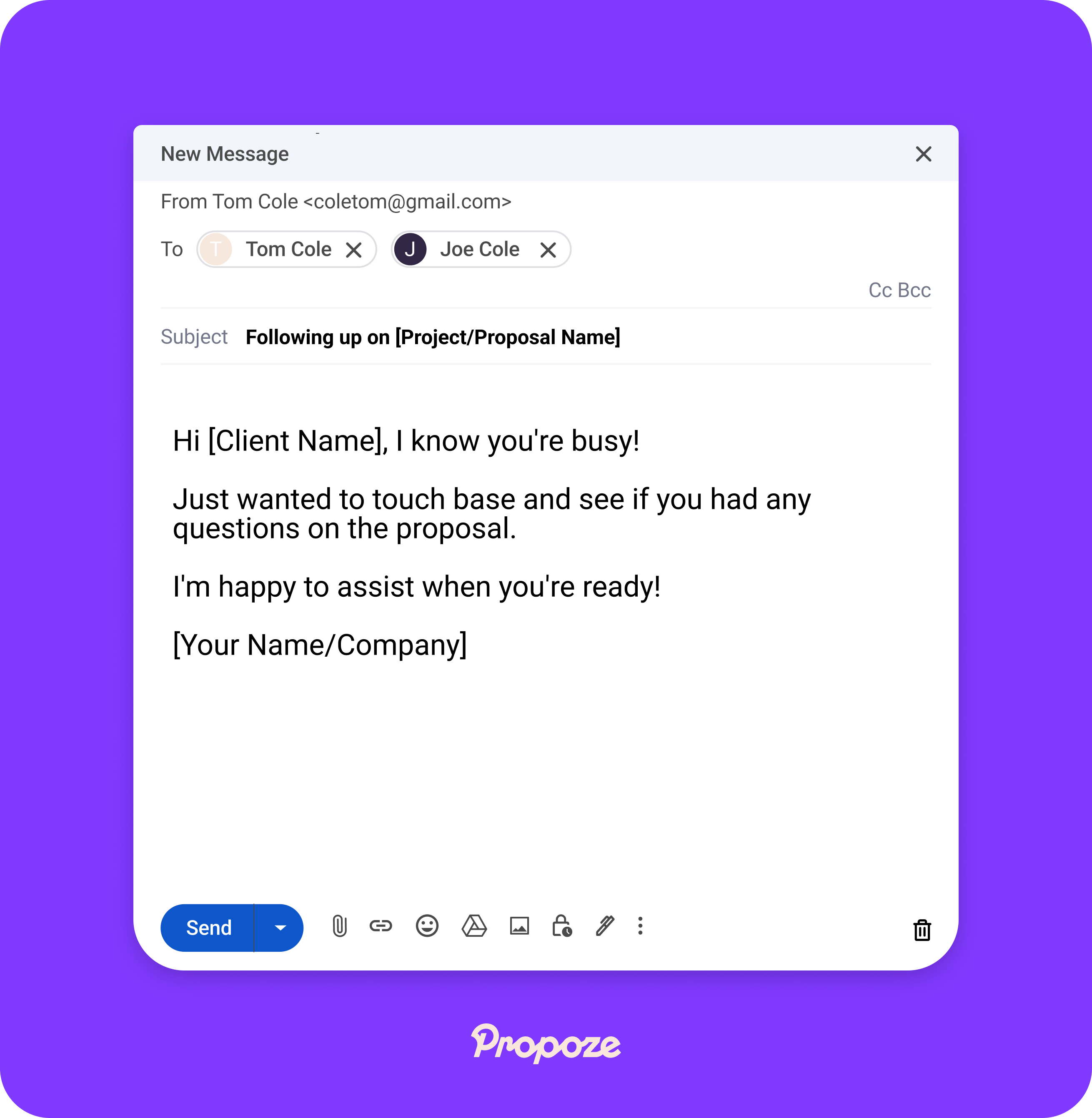
When to apply:
This is perfect for long sales cycles, larger deals, or when the client seems genuinely interested but needs time to evaluate or discuss internally. It shows persistence without pressure.
Tip #6 Send reminders at the end of the month
The end of the month can be an ideal time to send follow-ups, as many companies are wrapping up tasks, finalizing budgets, or preparing to close deals. It's a natural point when decision-makers are reviewing proposals and making decisions.
How to implement:
Schedule follow-ups near the last week of the month, gently nudging your prospect to prioritize your proposal as they finalize their plans.
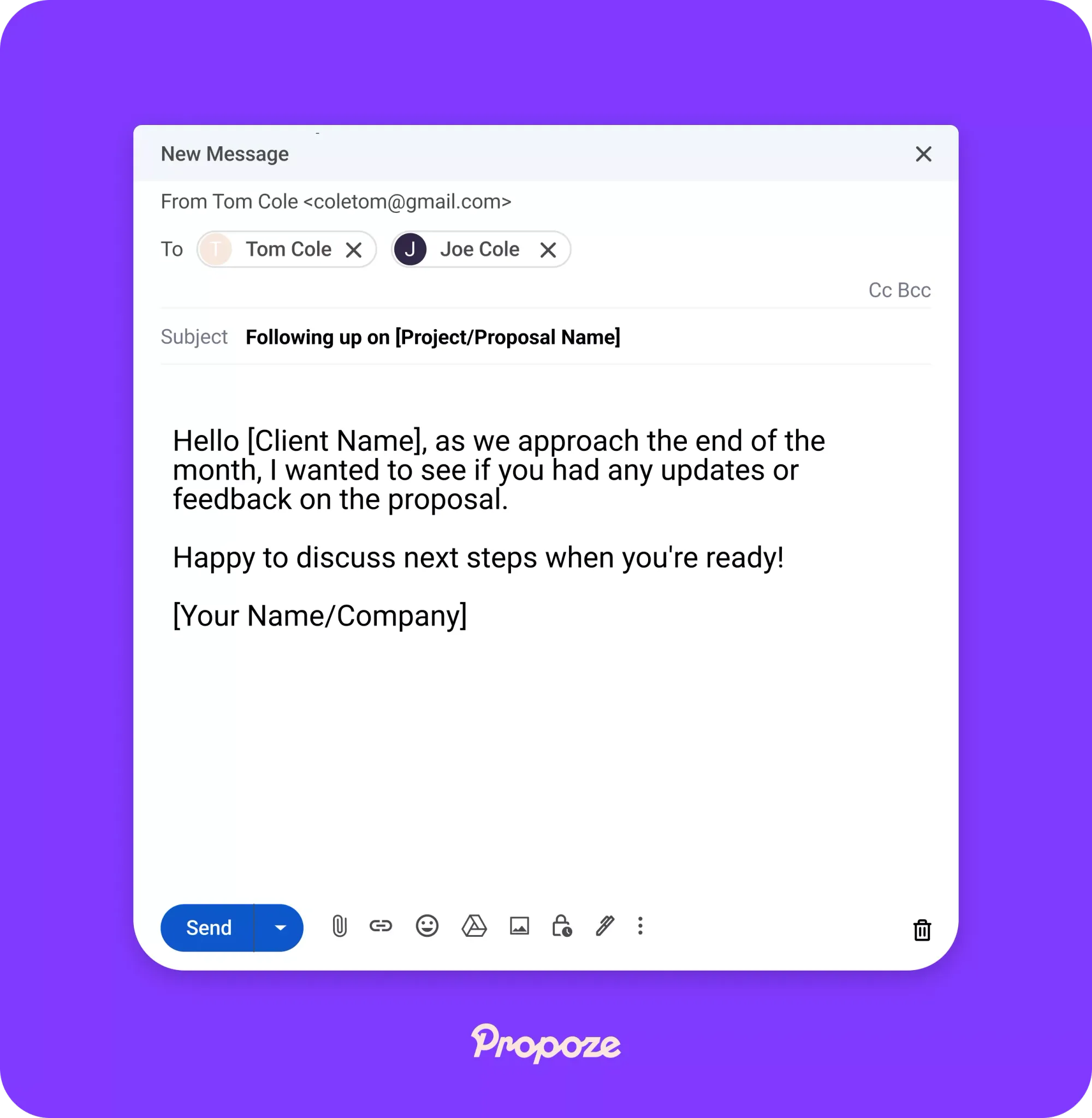
When to apply:
This works best for companies with quarterly or monthly cycles, especially for budget-related deals or contracts that need to be closed soon. It reminds the client to act before the month wraps up.
Tip #7 Prioritize your follow-ups based on deal size
Larger deals with prospective clients require more time, effort, and personal attention, emphasizing the importance of personalizing communication.
Prioritizing follow-ups based on deal size and understanding the prospect’s company ensures you’re investing your energy where the impact will be greatest.
A $100,000 deal needs more frequent and tailored outreach compared to a $1,000 contract.
How to implement:
For high-value deals, follow up more frequently (every 3-5 days) with personalized insights and progress updates. Smaller deals can have wider gaps between follow-ups (7-10 days), with more generalized check-ins.
Tip #8 Leverage engagement insights for smart follow-ups
Using engagement data helps you strike when the iron is hottest. When prospects open your email or view your proposal, that’s your cue to follow up with perfect timing.
This shows you’re attentive and responsive, which increases your chances of closing the deal.
How to implement:
Use tools like HubSpot, Right Inbox, or Mailtrack. These tools track email opens, link clicks etc.
When a prospect engages with your content, it’s the perfect time to send a follow-up email—while you’re still top of mind.
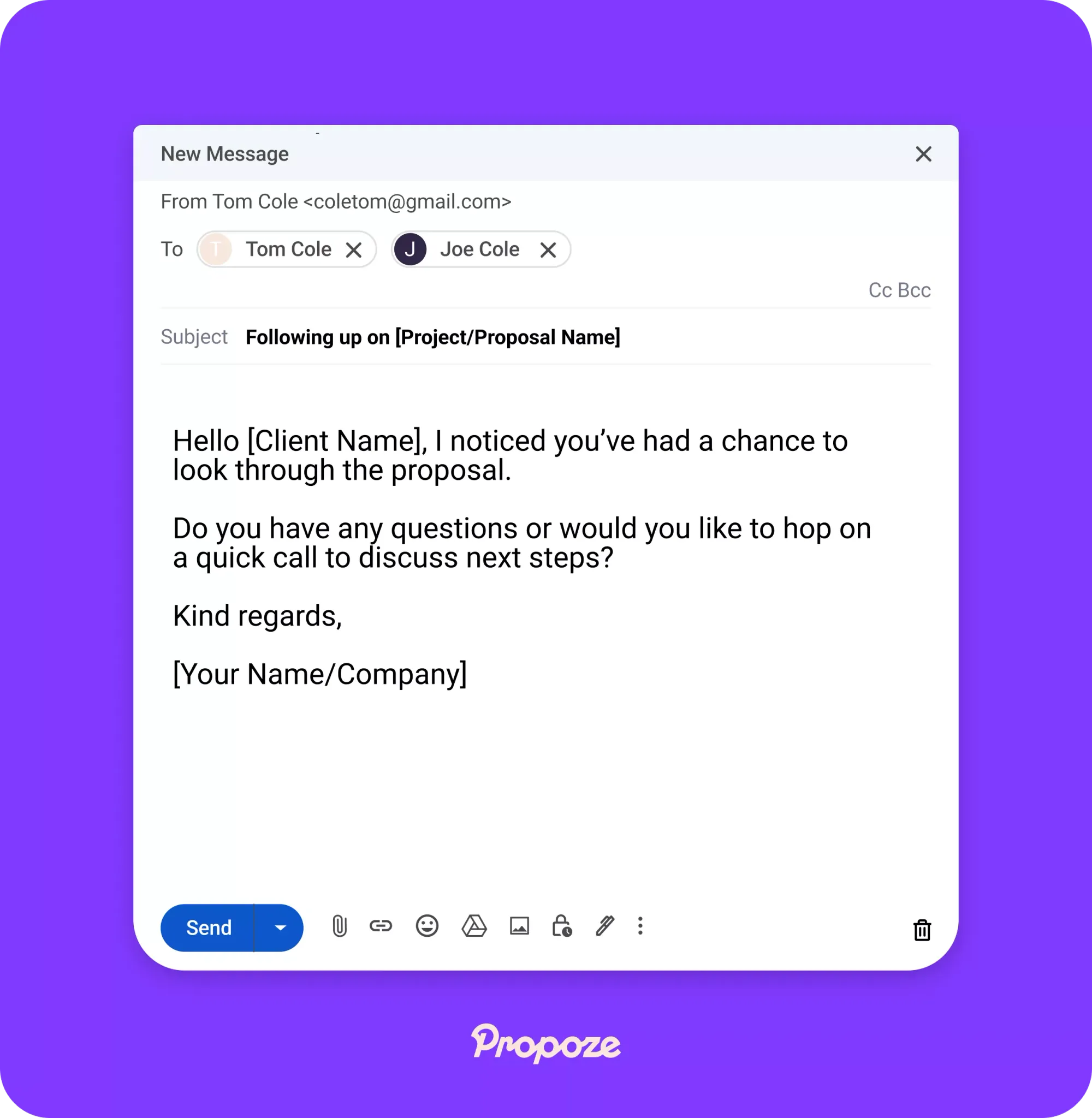
Why these tools are best:
- HubSpot: Offers in-depth analytics, real-time tracking of opens, and automations for follow-ups.
- Right Inbox: In addition to email tracking, Right Inbox offers email reminders, sequences, and scheduling features.
- Mailtrack: Provides straightforward, real-time alerts when your emails are opened, helping you follow up while it’s still fresh.
When to apply:
Use engagement insights to trigger follow-ups after significant interactions—such as multiple views of your proposal or a deep dive into your email.
Follow up quickly to catch the prospect while they’re still focused on your offer.
Tip #9 Use calendar invites for important follow-ups
Using calendar invites makes it easier for prospects to commit to a meeting, creating a sense of urgency and professionalism. It sets clear expectations for when you’ll connect next, reducing the chance of being forgotten.
How to implement:
In Google Calendar or Microsoft Outlook, click "Create Event," enter meeting details, and include a Zoom or Google Meet link.
Suggest 2-3 time slots to give flexibility and make it easy for your prospect to confirm. Set reminders so no one forgets!
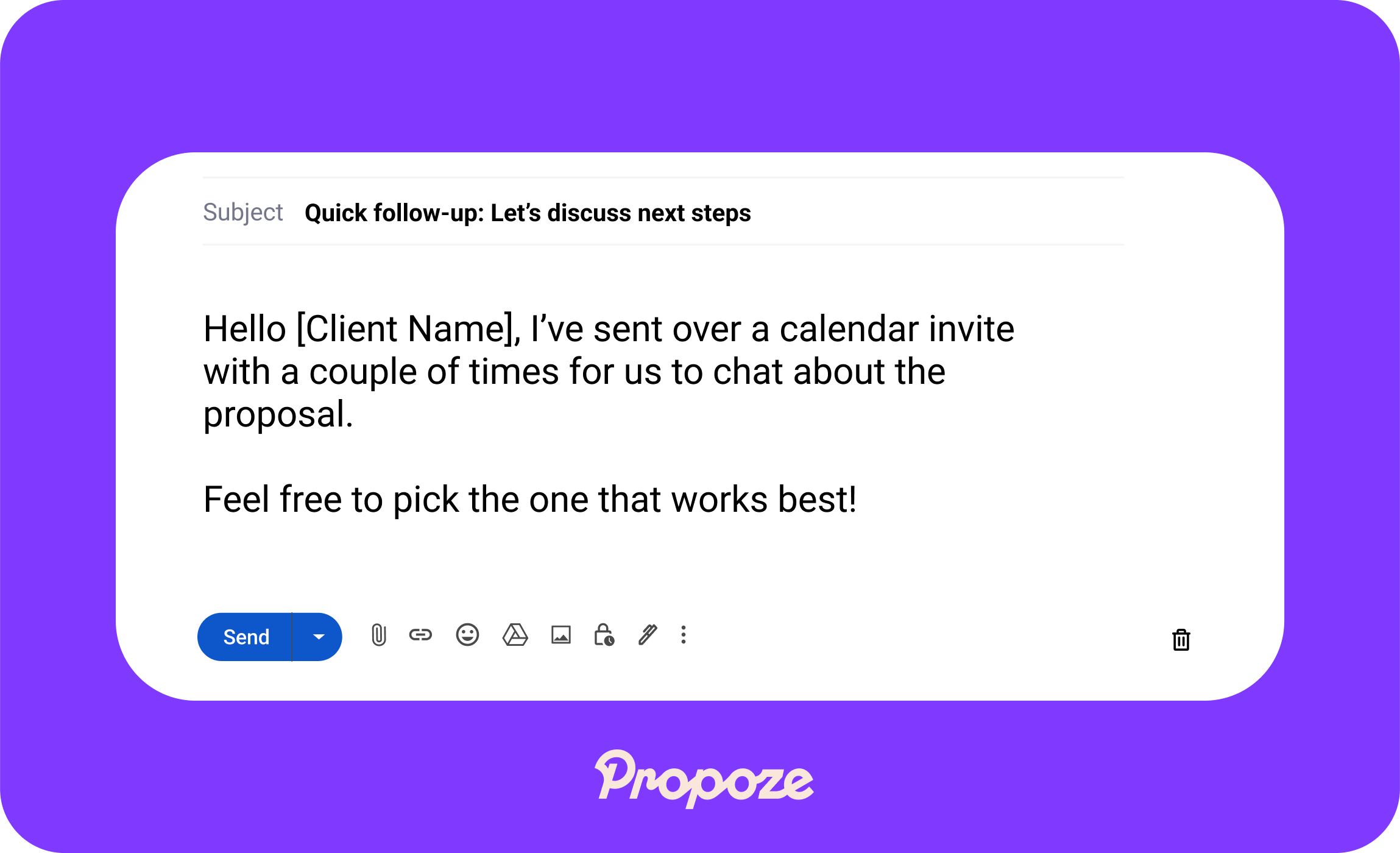
Tip #10 Adjust your follow-up frequency based on response behavior
The way your prospect responds (or doesn't) should guide how often you follow up. If they're engaged, you can follow up more frequently. If they've gone silent, space it out to avoid being pushy.
How to implement:
If a prospect is opening your emails, clicking on links, or responding, follow up within 2-3 days to keep momentum. If they’ve gone silent, stretch follow-ups to 7-10 days and offer new value with each message.
Real-life example:
Let’s say a client opens your proposal twice in one day but doesn’t respond—that’s a good sign they’re interested!
Follow up within 48 hours, referencing the proposal and offering to answer any questions they might have. On the flip side, if you’ve followed up a few times and still haven’t heard back, it’s better to give them some space.
Wait a week or more, and send a softer follow-up, like helpful insights or industry news, to stay on their radar without being too pushy.
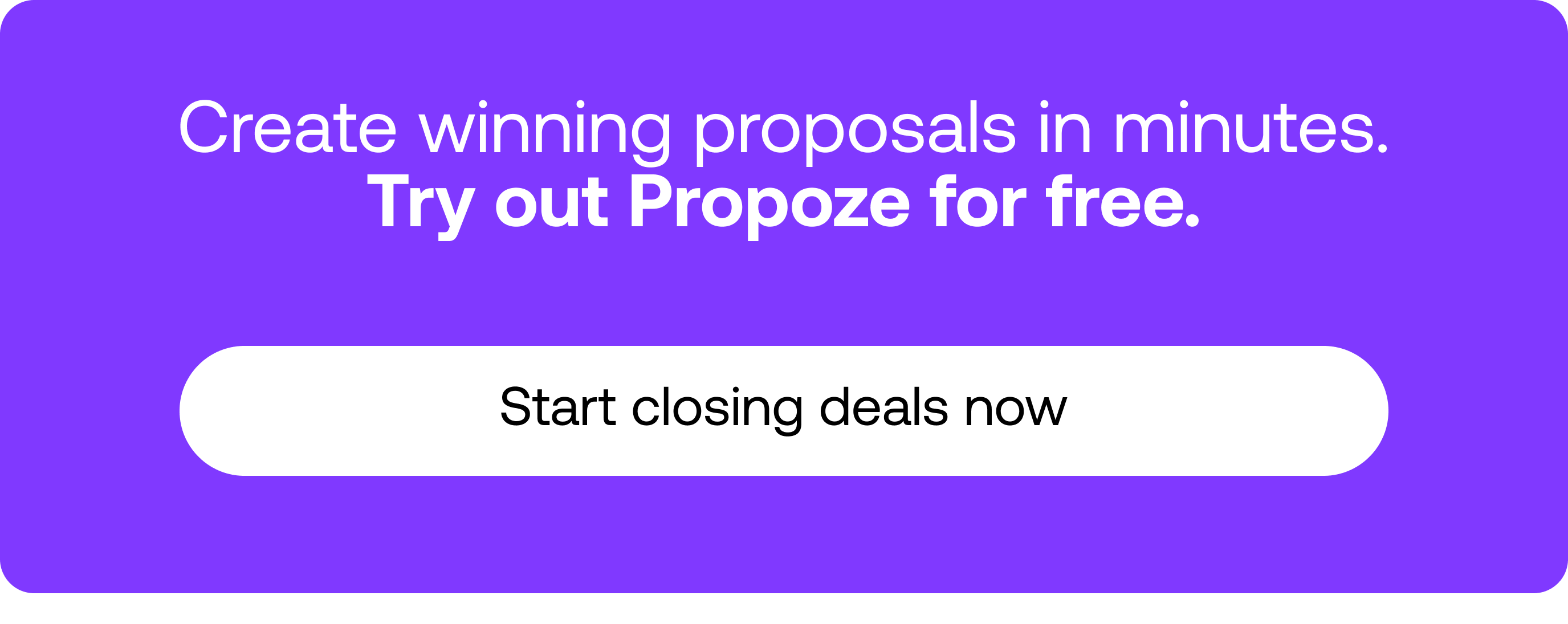
Tip #11 Know when to pause follow-ups
It’s crucial to recognize when your follow-ups aren’t yielding responses and take a step back.
Bombarding a prospect with messages can hurt your chances more than help them. If a prospect hasn’t engaged after 4-5 follow-ups, it’s time to pause and let the dust settle.
Example:
If a prospect has been silent after your last email, pause your outreach for a few weeks. When you re-engage, say something like, “I wanted to share some updates that might be helpful based on our last conversation.”
10 tips for crafting your follow-up message
Tip #12 Start with a polite but engaging reminder
When following up, referencing your last communication while offering new value is crucial. Sending a professional follow up email can help maintain business relationships and operational efficiency.
Avoid simply repeating your last message. A polite reminder can reignite interest if it’s tied to something helpful or relevant to their situation.
How to implement:
Start by thanking them for their time, briefly remind them of your offer, then add new information (e.g., updated insights or opportunities related to their business).

Why it works:
By combining a reminder with new, valuable content, your follow-up feels fresh rather than repetitive. This approach shows that you’re keeping their specific needs in mind and actively thinking about how to help.
When to apply:
This is perfect for your first follow-up or when you sense hesitation. It encourages them to re-engage by offering new value without pressure.
Tip #13 Hyper-personalize your message
Hyper-personalization means tailoring your follow-up to your prospect's specific industry challenges and goals. We all already know that personalization is super important.
Recent report by Gartner indicates that 80% of consumers are more likely to do business with a company that offers personalized experiences.
Let's take the manufacturing industry as an example. Instead of generic follow-ups, you'd show you understand their pain points, such as supply chain issues or operational inefficiencies.

Why it works:
It shows you're aligned with their exact needs, positioning you as a partner who understands their industry.
When to apply:
Use this method for every follow-up, especially for industries with specific challenges, to stand out as a relevant solution provider.
Tip #14 Provide value with every message
Every follow-up email should give the prospect something useful.
Instead of just checking in, offer value in the form of insights, resources, or ideas that can help them solve a problem or achieve a goal.
How to implement:
Share relevant case studies, industry reports, or tips related to their challenges. For example, if you’re emailing a tech company, you might send them a study showing how your solution improved productivity for a similar company.
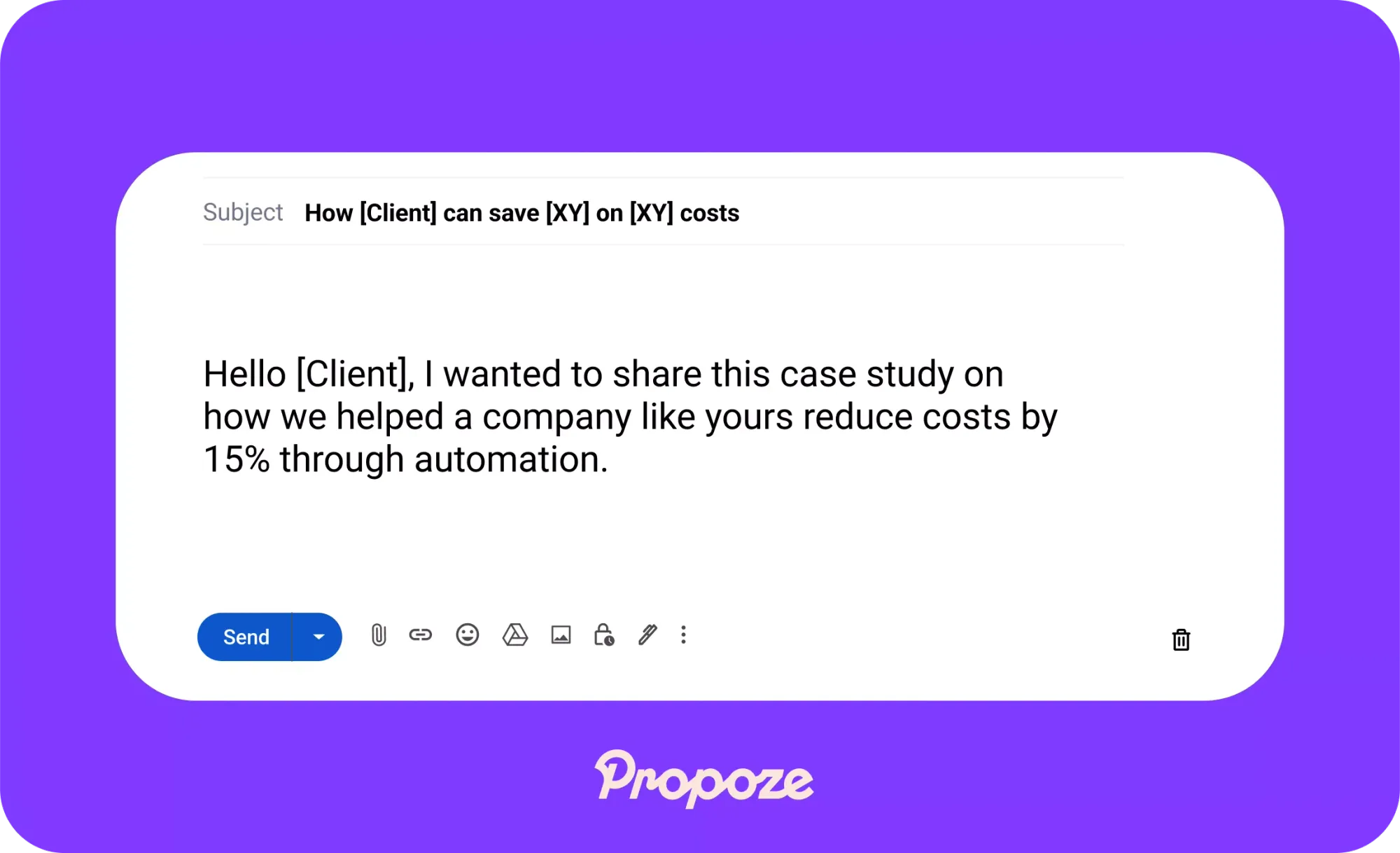
Why it works:
Offering value keeps your follow-ups from feeling pushy and instead positions you as a helpful resource.
When to apply:
Use this in every follow-up. By providing value, your emails become more than just reminders they become opportunities for your prospect to gain something useful.
Tip #15 Be direct, yet respectful
In the SaaS industry, time is critical for decision-makers. To keep your follow-ups effective, be clear about what you need without being pushy.

Tip #16 Craft irresistible subject lines
Your subject line is the first thing a prospect sees—so it has to grab their attention. Furthermore, personalized subject lines generate 50% higher email open rates.
Use curiosity, urgency, or personalization to entice them to open the email. Subject lines under 50 characters tend to perform best.
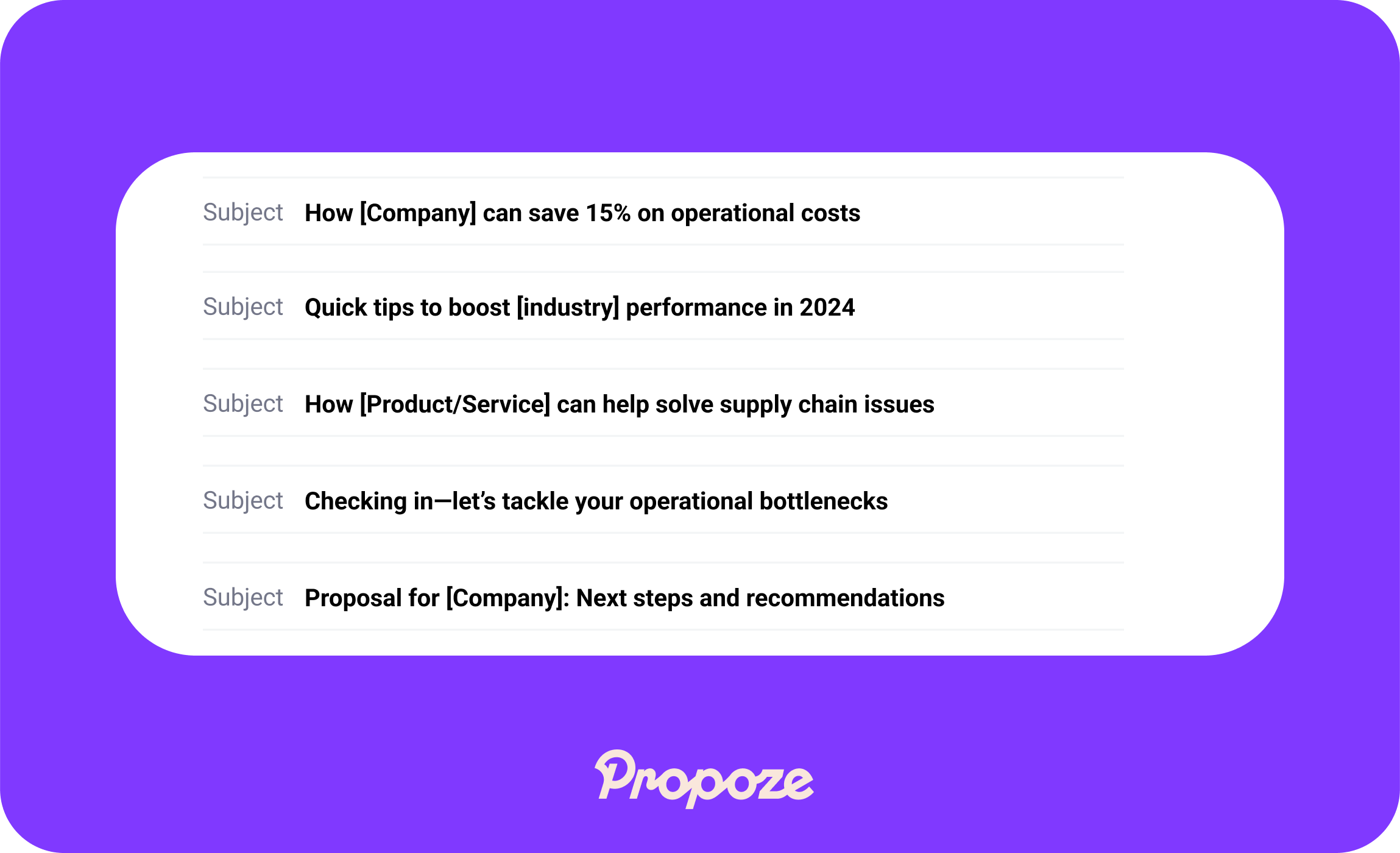
Tip #17 Encourage dialogue with open-ended questions
Asking open-ended questions encourages your prospects to share more, leading to genuine conversations.
Instead of asking yes/no questions, try asking things like, "How is your team currently addressing [challenge]?"
This gives them room to explain their situation, which can reveal insights and help you provide a tailored solution.
Why it works: It makes the conversation feel more collaborative and positions you as someone looking to understand and help.
Tip #18 Overcome objections proactively
Addressing potential concerns before they arise is a powerful way to build trust and eliminate roadblocks.
Research by Gartner reveals that 77% of B2B buyers state their latest purchase was complex or difficult, often due to unanswered concerns.
By proactively addressing these challenges, you can make the buying process easier.
How to implement:
For example, say, "I know budget can be a concern, but similar clients have seen savings within the first quarter, and I’d be happy to discuss ways to make this investment work for you."
Why it works:
It positions you as a proactive partner, not just a vendor, increasing trust and easing their concerns before they stall the deal.
Tip #19 Use a friendly, conversational tone
Being friendly and conversational makes your follow-ups more engaging and approachable while maintaining professionalism.

Tip #20 End with a clear, actionable next step
Each follow-up should lead the prospect toward a specific action, whether that’s scheduling a meeting, reviewing your proposal, or providing feedback.
A well-defined next step makes it easier for the prospect to respond and keeps momentum going. In fact, research from Forrester shows that 82% of B2B decision-makers want clear and specific next steps after receiving a proposal.
How to implement:
End your email with one clear action. Instead of leaving the decision open-ended, guide the prospect toward a specific time or action.
For instance, “Let’s book a quick call to go over any questions. I’m available on Tuesday at 3 PM—does that work for you?”
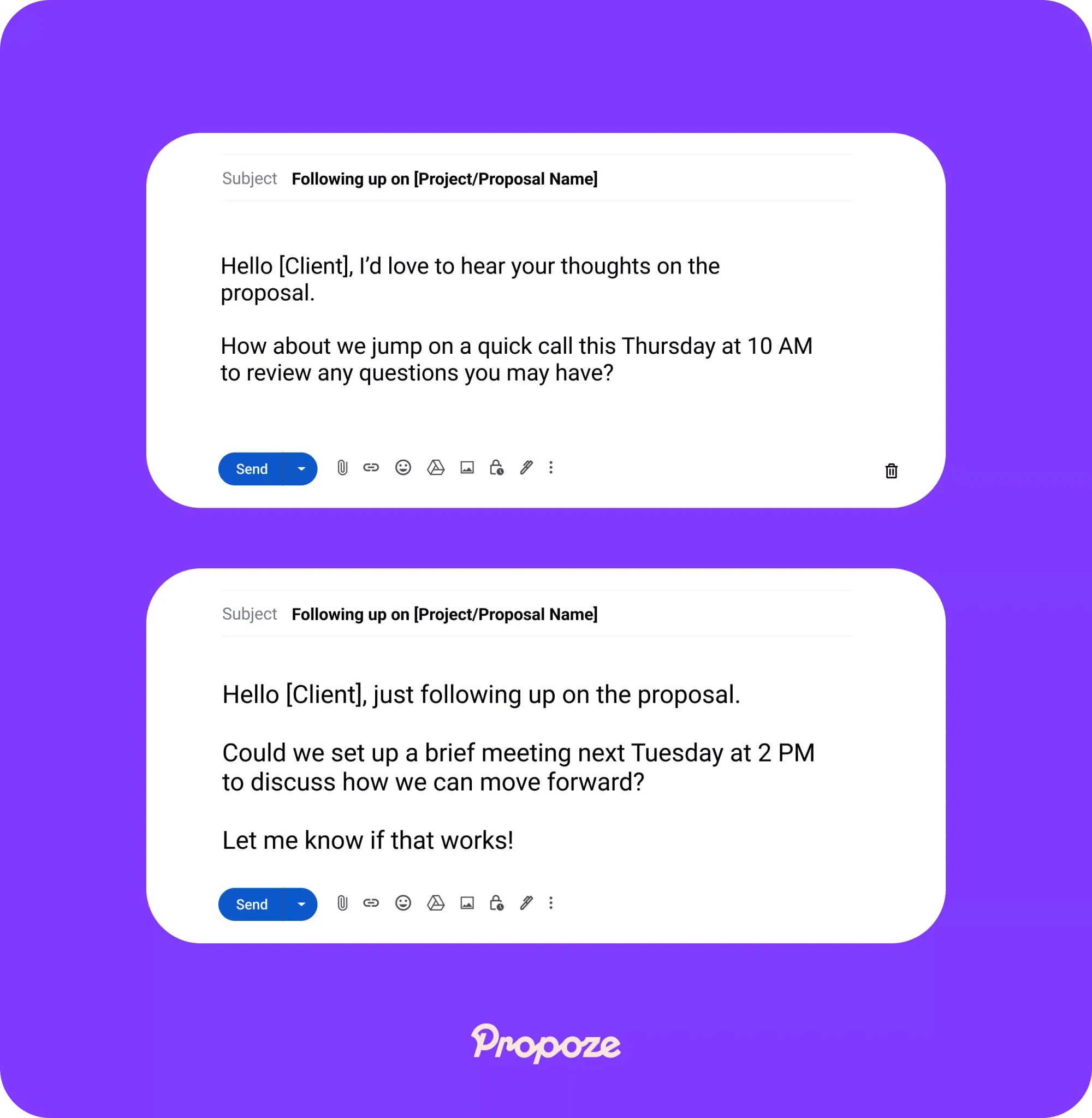
Tip #21 Avoid generic “checking in” messages
Generic follow-ups often feel repetitive and don’t provide value. Make your follow-ups meaningful by crafting a thoughtful sales follow-up email that avoids empty check-ins and adds useful content or insights with each touchpoint.
To illustrate best practices, consider using follow-up email examples that demonstrate effective communication strategies. These examples can help convert prospects into clients by enhancing engagement and increasing conversions.
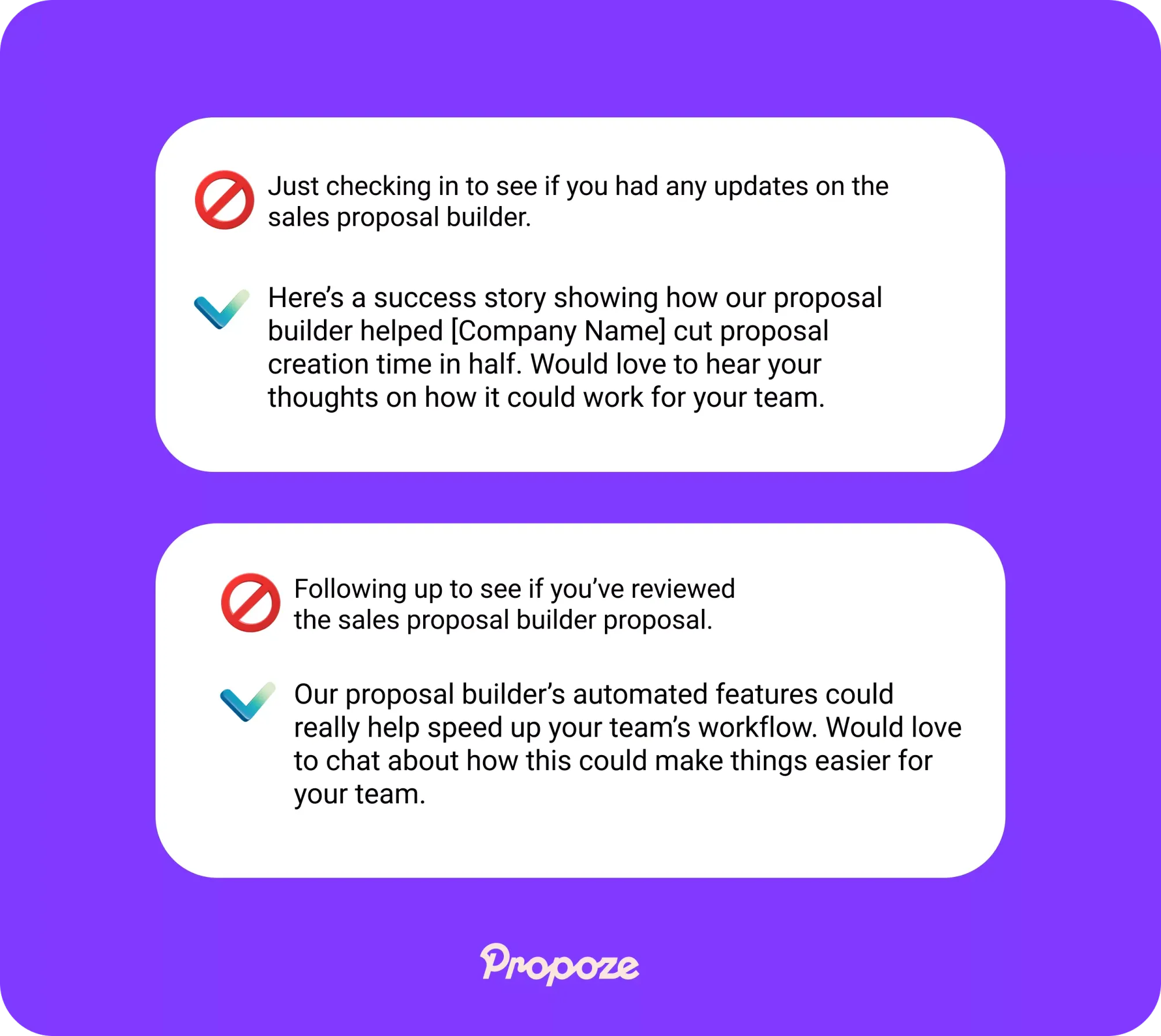
10 tips for personalizing and automating your follow-ups
Tip #22 Use AI tools to suggest tailored content based on client behavior
AI can help you personalize follow-ups by analyzing client interactions and suggesting relevant content.
Tools like Drift or Optimove use AI to track how clients engage with your emails, proposals, or website, and then recommend content (blogs, case studies, or articles) that aligns with their behavior and interests. For instance, you can use AI to generate a sample follow-up email that maintains professionalism and reiterates your interest while respecting the client's circumstances.
How to implement:
Integrate AI tools into your CRM or email platform to automatically analyze client behavior, such as which sections of your proposal they viewed or how they engaged with your emails.
Based on this, AI can suggest content like relevant case studies or blog posts that address the specific challenges or interests they’ve shown. This keeps your follow-up both relevant and value-driven.
Tip #23 Personalize follow-ups by referencing the client’s competitors
Mentioning a client’s competitors or relevant industry trends adds urgency and personalization to your follow-ups.
This approach shows you’re in tune with their market landscape and offers insights that could give them a competitive edge.
How to implement:
Research recent news or developments about their competitors and include relevant insights in your message.
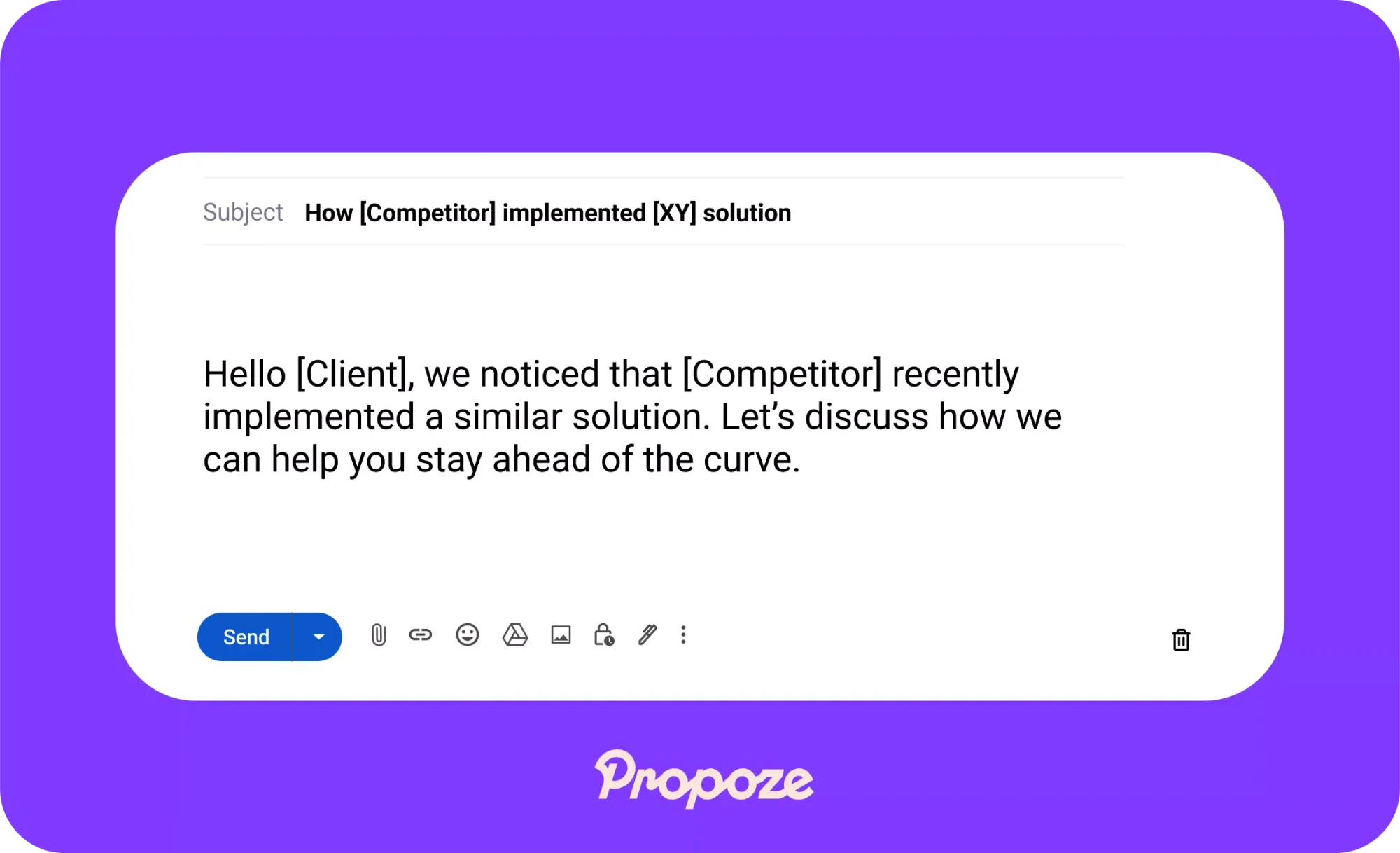
Tip #24 Automate follow-ups with split-testing to optimize content
A/B testing helps you optimize your automated follow-up emails by testing different content approaches.
Whether it’s subject lines, tone, or call-to-action placement, split-testing ensures that you're continuously improving and adapting to what resonates best with your prospects.
Test variables such as:
• subject line length
• personalized content
• call-to-action wording, etc.
For example, test "How [Company] can increase efficiency by 25%" versus "Quick update on your proposal." Review the data to see which version drives more engagement.
Suggested tools:
• Brevo
• Klaviyo
• ConverKit
Tip #25 Leverage geolocation data for hyper-relevant follow-ups
Using geolocation data allows you to specialize your follow-ups to regional trends, local challenges, or upcoming events that matter to your prospects.
This adds a personalized touch that shows you understand their local context and makes your emails more relevant.
How to implement:
Use tools like ZoomInfo to gather geolocation data and incorporate local insights into your follow-up.
For example, reference regional industry trends, upcoming conferences, or local challenges.
This could be particularly impactful for industries like manufacturing, where local regulations or supply chain factors are important.
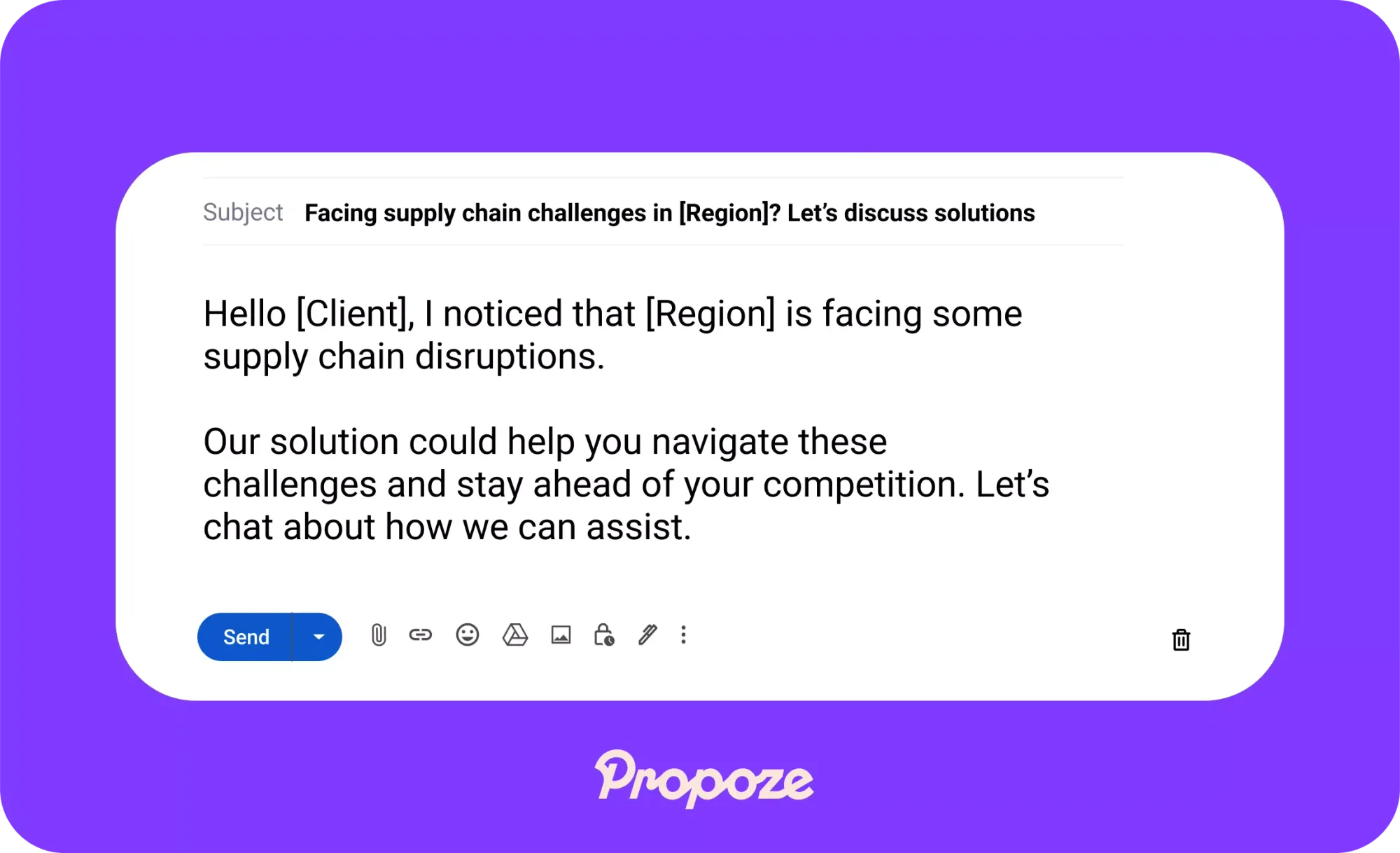
Tip #26 Use customer lifetime value (CLV) to prioritize follow-ups
Customer Lifetime Value (CLV) is a powerful metric that helps you determine which clients are worth your time and attention in the long run.
By calculating the potential revenue a prospect can bring over their entire relationship with your business, you can segment your follow-up efforts to maximize efficiency and impact.
High-CLV prospects should receive more personalized and frequent follow-ups, while lower-CLV prospects can be placed on a more automated track.
How to implement:
Integrate your CRM with CLV analytics tools (like Salesforce, Zoho CRM, or HubSpot) to calculate projected CLV for each prospect. Based on this data, create distinct follow-up workflows:
- High CLV clients: Use more personalized emails, tailored offers, and direct outreach such as calls or video meetings.
- Lower CLV clients: Automate the follow-up process using broader messaging or pre-built sequences to nurture their interest.
For a high-CLV prospect:
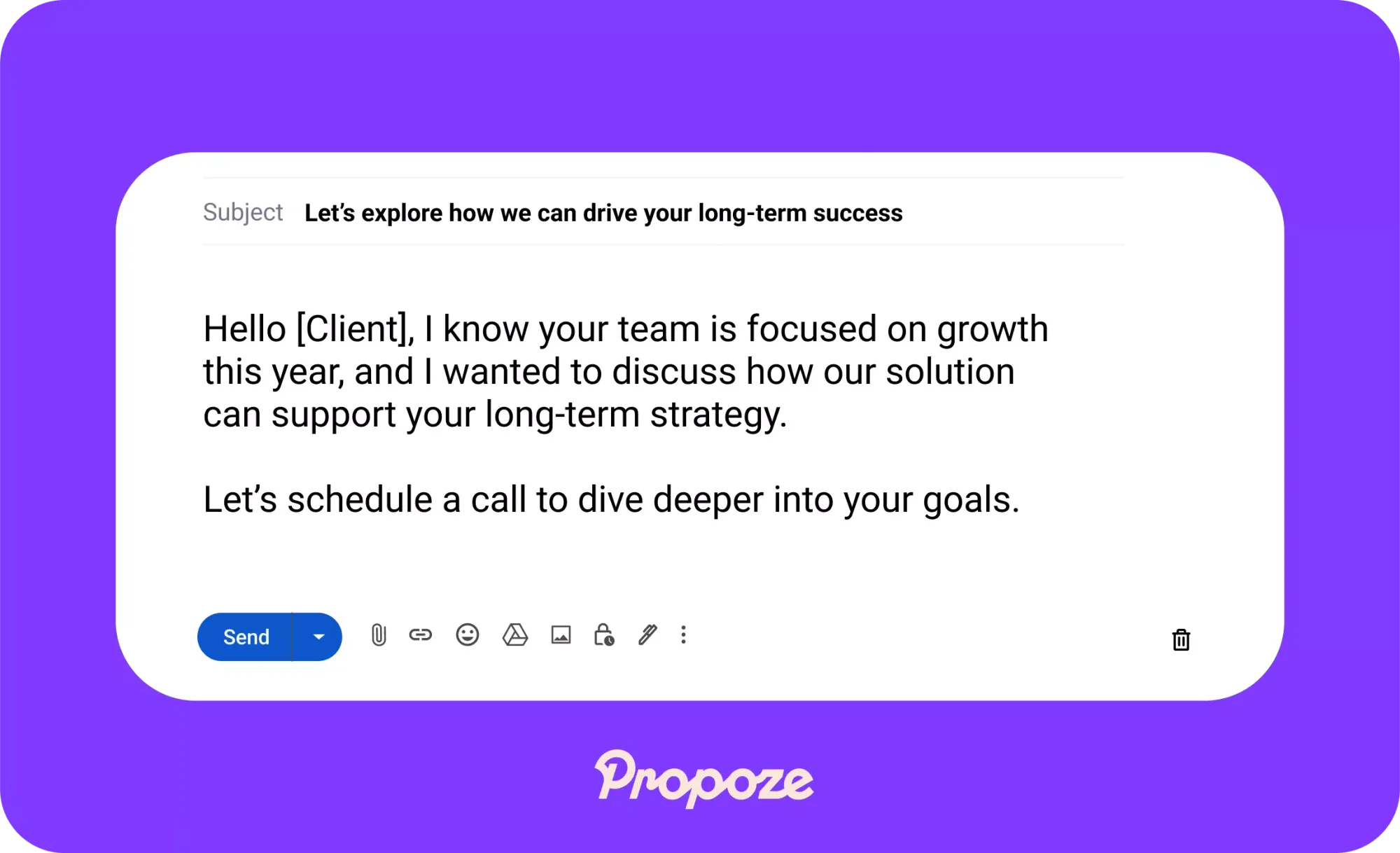
For a lower-CLV prospect:
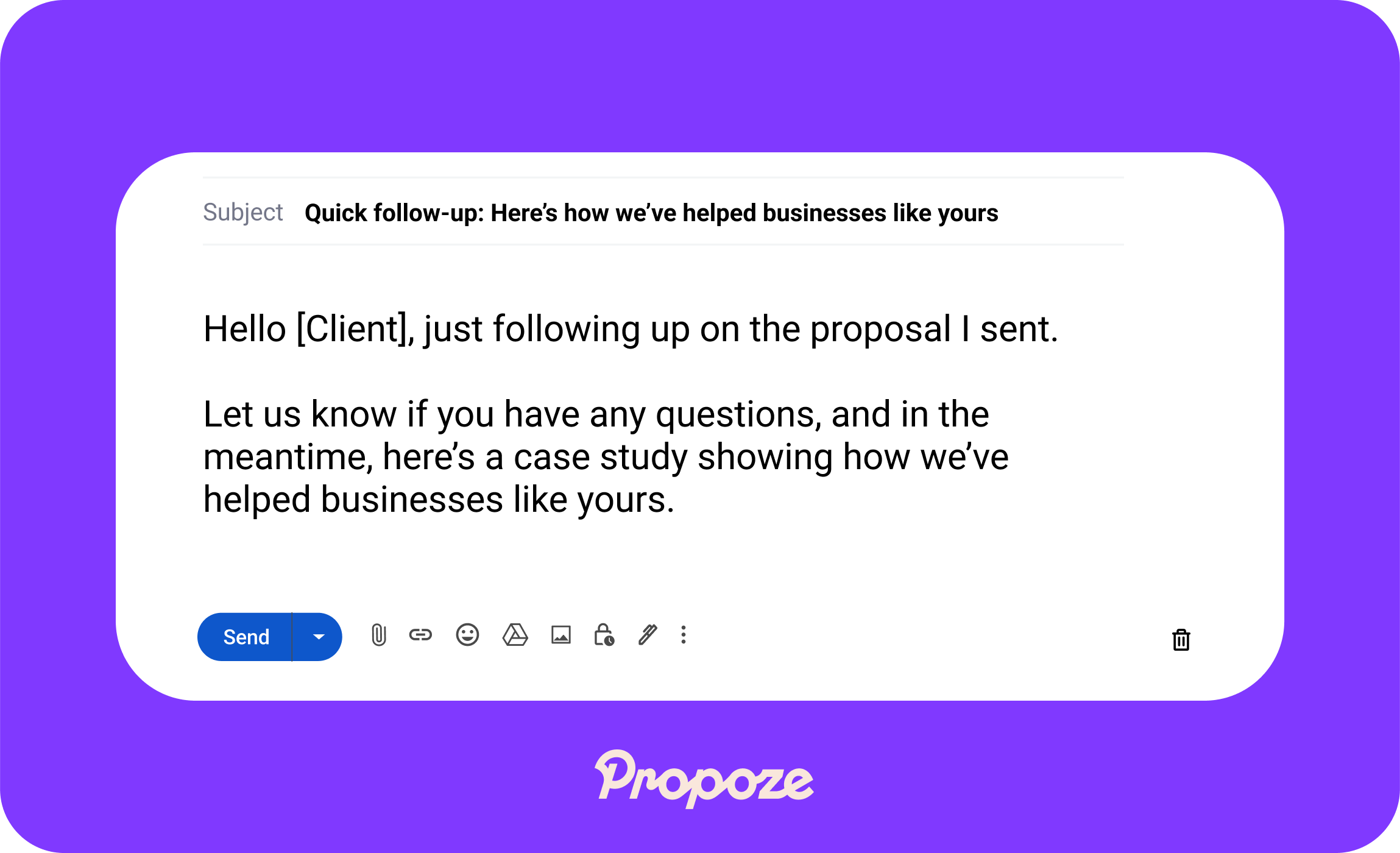
Tip #27 Personalize follow-ups using social media interactions
Tracking how prospects interact with your brand on social media gives you a goldmine of information to personalize your follow-ups.
By referencing specific social media actions—such as liking a post, sharing content, or commenting—you can make your follow-ups feel timely and highly relevant.
How to implement:
Integrate your CRM with social listening tools like Hootsuite or Sprout Social.
These tools help track interactions such as likes, shares, comments, or mentions on your brand’s social channels.
Use this data to create follow-ups that reference specific actions. For example, if a prospect liked a post about your product’s new feature, mention that in your follow-up and provide more insights.
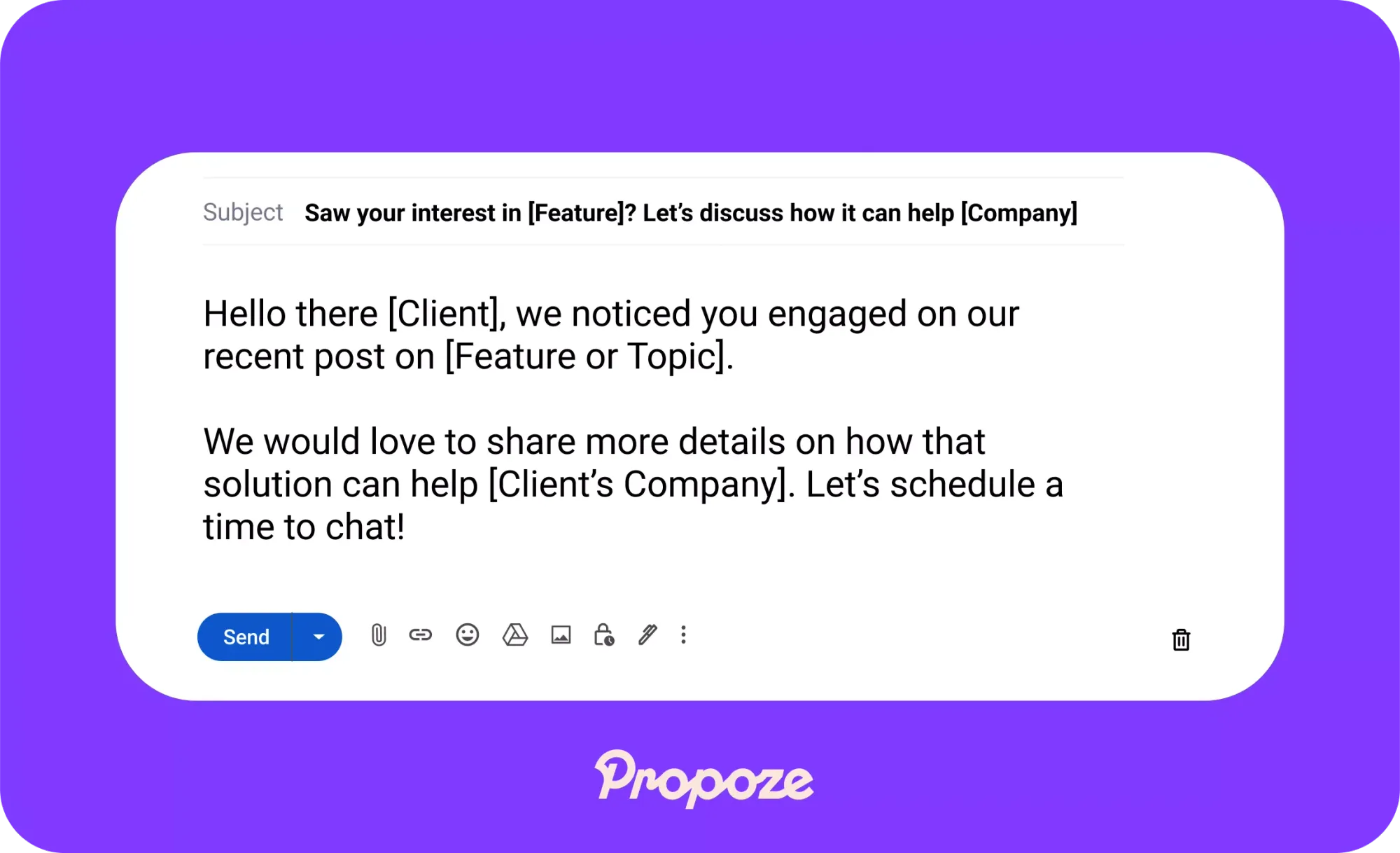
Tip #28 Include personalized video follow-ups
Sending personalized video messages can make your follow-up stand out in a crowded inbox. Tools like Loom or Vidyard allow you to send quick, personalized video updates that humanize the process.
How to implement:
Record a quick video addressing the prospect by name and discussing their specific business needs. Use video hosting platforms that integrate with email clients to ensure smooth delivery.
Tip #29 Leverage customer testimonials or success stories in follow-ups
Including a relevant customer testimonial or success story in your follow-up can add credibility and demonstrate the real-world benefits of your solution.
Prospects are more likely to trust your proposal when they see how others have successfully implemented it.
How to implement:
In your email, mention how a similar client faced the same challenge and saw measurable success after adopting your solution.
For example: "One of our clients in your industry saw a 25% reduction in project delays using our tool."
Tip #30 Use dynamic content in automated emails
Automation doesn’t have to feel robotic. Use dynamic content to make your automated emails feel personalized.
Dynamic fields can insert the prospect’s name, company, or specific industry challenges directly into the email body, making the message feel tailored.
How to implement:
Leverage tools like Mailchimp or HubSpot to automate emails that include dynamic content fields for personalized greetings or references to the recipient’s industry.
Optimize your sales follow-up with Propoze
Effective sales follow up emails are key to closing deals, and the right templates can make it easier. These emails are crucial communication tools in the sales process, helping to nurture customer relationships, provide updates, and clarify next steps.
Whether it’s checking in at the right time or offering value, being clear and consistent helps turn prospects into loyal clients.
With Propoze, you can take your follow-ups to the next level by tracking and managing your proposals in one place, helping you stay organized and focused on what matters most.
With , you can easily enhance the creation of follow-ups that move the conversation forward and increase your chances of success.
Ready to transform your follow-ups?
Try Propoze today with our free trial!